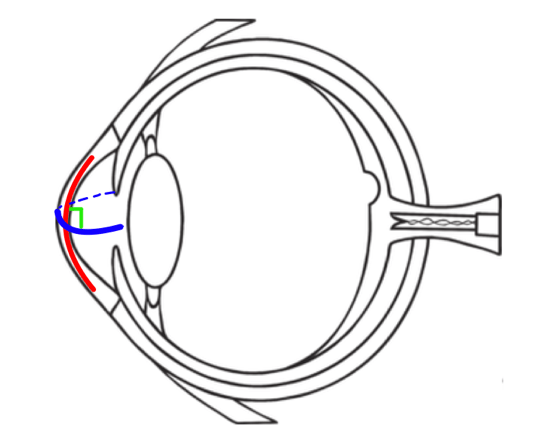Your Eye Clinic For The Treatment of Irregular Astigmatism
At The Contact Lens Institute of Nevada we aim to provide eye care services and vision correction solutions to all our patients, regardless of how complicated their situation may be. That’s why we offer comprehensive eye care for patients with irregular astigmatism. What causes irregular astigmatism, can it get worse and if so, what causes it to get worse? Find answers to all of these questions and more, below.
1. What makes irregular astigmatism different from regular astigmatism?
Typically, the cornea (the top layer of the eye) is not a perfectly shaped sphere. Instead of one uniform curve, there are two uneven ones.
Regular astigmatism, which is more common, is when the eye’s two curved surfaces are perpendicular to each other (blue and red lines, Figure 1). Due to this being the most common form of astigmatism, glasses and “off the shelf” contact lenses are made for these individuals.
Glasses and contact lens prescriptions with regular astigmatism have two different power numbers, one for each curve in order to focus light together instead of in two separate spots. Unfortunately, prescriptions can only be written for regular astigmatism. Irregular astigmatism is when the two different curves are not perpendicular to each other(blue and red lines, Figure 2). Due to this irregularity, contact lenses need to be personalized to match these curves.
The terms irregular and regular astigmatism are used to describe the curvature of the eye, not necessarily the health of the eye. The eye can have either type of astigmatism and still be considered healthy.

2. What Causes Irregular Astigmatism?
Not all causes of irregular astigmatism are known, but eye care experts have linked it to systemic and ocular diseases and conditions that cause the cornea to warp or thin, injuries from sports or work, and procedures such as LASIK and other types of vision correction surgery.
Causes of Irregular Astigmatism
Keratoconus: This condition thins and weakens the central cornea until the age of 30-40, causing it to bulge outwards. This thinning causes the cornea to go from being rounded and smooth to being pointed, creating a cone-like shape, and making the corneal surface uneven.
Pellucid marginal degeneration: This condition is very similar to keratoconus, except that it continues throughout life. Specifically, the lower third of the cornea continues to thin and weaken. This creates a protrusion at the bottom, resembling a belly shape.
Keratoglobus: This condition is also similar to keratoconus, except that the cornea thins and weakens in the periphery creating a very rounded bulging ‘globe’ appearance.

Trauma to the eye: A deep cut or tear, stitches, or warpage from a previous contact lens fitting too tight can change the curves on the cornea.
Corneal surgery: Corneal transplant/partial corneal tissue replacements and refractive surgeries can lead to complicationsof changing curves on a cornea. A list of procedures are as follows:
-DALK (Deep anterior lamellar keratoplasty)
-PKP (Penetrating keratoplasty)
-RK (Radial keratotomy)
-PRK (Photorefractive keratectomy)
-LASIK (Laser in-situ keratomileusis)
Advances in technology have successfully helped diagnose and assess the conditions above, which in turn helps us provide the best care for our patients.
3. Treatments for irregular astigmatism
Most irregular astigmatism patients will need to wear a special type of contact lens or have a surgical corneal transplant.
There are a number of specialty contact lenses that are an excellent non-surgical alternative to improve vision.
Scleral contact lenses:
These lenses vault over the cornea and sit on the sclera (the white portion of your eye). By creating this vault, it provides a uniform surface over the abnormal curvature and is then able to provide a clearer image. The fit and power of the lens can be customized to the patient’s eye for comfort and better vision.
Specialty soft contact lenses:
Soft lenses have the ability to drape over and match the irregular astigmatism on the eye. For a precise and comfortable fit, the parameters of curvature and power can be personalized to match the patient’s needsexactly.
Gas permeable contact lenses:
These lenses are smaller than a scleral or soft contact lens. Gas permeable lenses allow for tears to pool underneath the lens and fill in the gaps of the irregular curves in order to improve vision.
Hybrid lenses:
These lenses are called a ‘hybrid’ due to the center being a gas permeable contact lens with a soft contact lens skirt surrounding the gas permeable lens portion. This allows for improved vision with increased comfort on the eye.
Combination of gas permeable and soft contact lens (“piggy back”) system:
This combination of the two different lenses provides protection and cushion over sutures or a graft (from a past corneal transplant procedure, for example) with the soft lens, and then putting on the gas permeable lens over top to sharpen vision.
4. What are symptoms of irregular astigmatism?
Due to the cornea having an irregular curvature, a variety of symptoms can be associated. Most symptoms have to do with the ability to see clearly. Some of the most common complaints are:
- Blurry vision at all distances
- Glasses aren’t helping with vision
- Glare
- Starbursts
- Haloes around lights
- Poor night vision
- Distortion
- Trouble with everyday activities due to decreased vision
- Fatigue
- Eyestrain
- Headaches

5. Can irregular astigmatism get worse?
Depending on the cause, your irregular astigmatism may get worse over time. This is especially true if it resulted from a degenerative condition that continues to get worse (for example, keratoconus or pellucid marginal degeneration), or an injury that has not yet fully healed.
However, if your degenerative condition is stable, or your injury has already healed, there is a high likelihood that the irregular astigmatism will remain stable as well. Like with an injury, if the irregular astigmatism is a result from a procedure, the irregularity should remain relatively stable once the eye is no longer in the recovery stages.
6. Is irregular astigmatism genetic?
On its own, irregular astigmatism isn't considered a condition that's passed down to your children. However, many of the conditions that can cause irregular astigmatism can be passed down. These include keratoconus and Anterior Basement Membrane Dystrophy. If you've been diagnosed with one of these conditions, it may be a good idea to inform your family, so that they can come in for an eye exam to determine their risk for irregular astigmatism.

